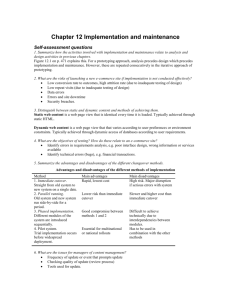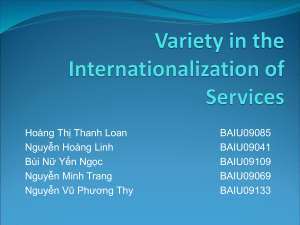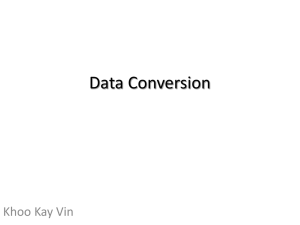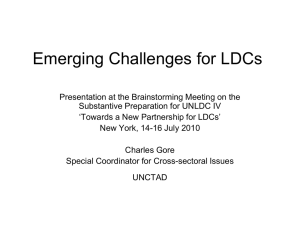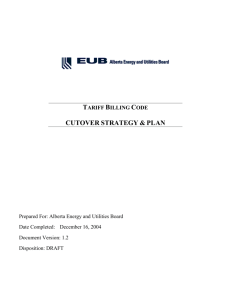Cutover Procedures - Ontario Energy Board
advertisement
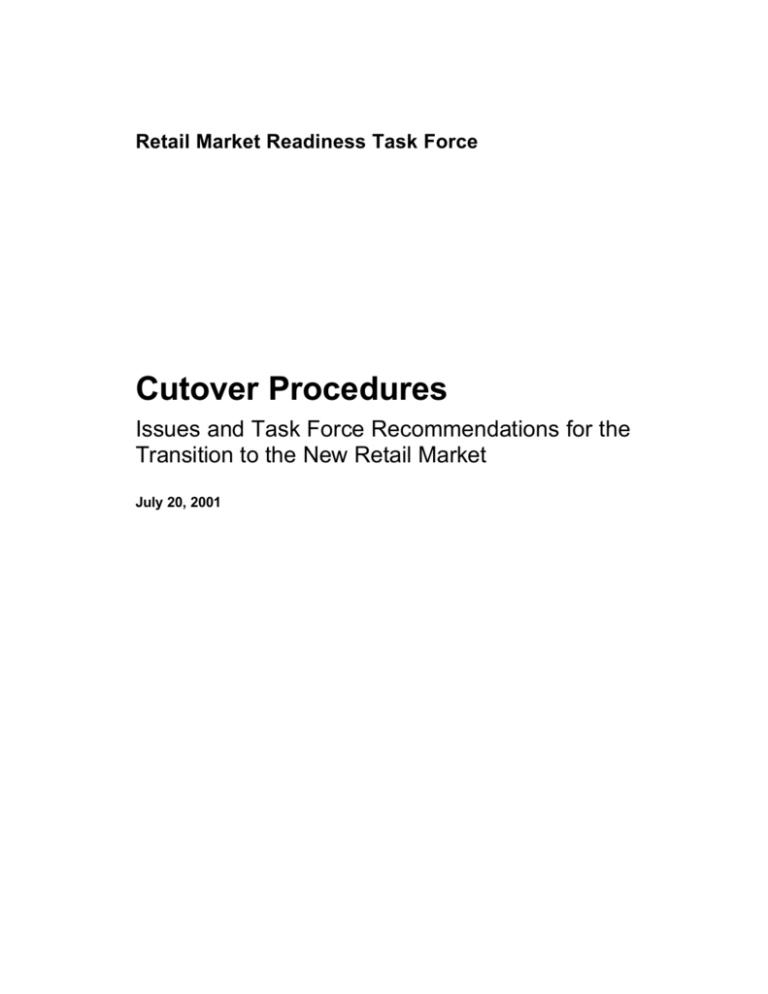
Retail Market Readiness Task Force Cutover Procedures Issues and Task Force Recommendations for the Transition to the New Retail Market July 20, 2001 Cutover Document Table of Contents T ABLE OF CONTENTS ............................................................................................................... 1 1 INTRODUCTION.................................................................................................................. 2 2 IMPLEMENTATION OF NEW PRICING STRUCTURE ................................................................ 3 2.1 Non-Interval Metered Customers ............................................................................... 3 2.2 Interval Metered Customers ....................................................................................... 4 3 CUSTOMER ENROLMENT................................................................................................... 5 3.1 Accepting enrolments.................................................................................................. 5 3.2 Contestability rules pre and post market opening ...................................................... 5 3.3 Blackout periods .......................................................................................................... 6 3.4 Renumbering of accounts ........................................................................................... 6 4 PRUDENTIAL REQUIREMENTS ............................................................................................ 8 4.1 Timing of posting pre-market opening. ....................................................................... 8 Issue 1.0 - Final Page 1 of 8 July 20, 2001 Cutover Document 1 Introduction This document is a summary of the Retail Market Readiness Task Force recommendations for Cutover procedures. The Cutover issues are related to the transition from legacy systems to the new market systems. In making this transition, a local distribution company (LDC) needs to determine the timing of the introduction of unbundled bills and retail access for customers on interval and non-interval meters relative to the market opening date. In addition there is the need to determine the timing of when a retailer must post pre-market opening prudentials. The cutover procedures are here defined as the required transitional procedures for the period leading up to and just after market opening. Three areas of concern have been identified relative to Cutover: 1. Implementation of new market pricing structure at the end-use customer level; 2. Enrolment of customers; and 3. Posting of prudentials by retailers. Issue 1.0 - Final Page 2 of 8 July 20, 2001 Cutover Document 2 Implementation of new pricing structure 2.1 NON-INTERVAL M ETERED CUSTOMERS Following market opening, LDCs must introduce unbundled bills including energy charges based on the IMO administered hourly spot market price. Since customer billing cycles vary, the transition or cutover bill will likely be based on both pre and post market opening cost of power rates. A second issue is the need to ensure that customers who enrol with retailers are billed on retail energy rates as soon as possible post-market opening. The Task Force recommended that all accounts be switched as soon as possible, but that an actual meter value must occur for the switch to go ahead. In addressing these issues, two options for implementing the new pricing structure have been developed: 2.1.1 Method 1: Pro-rated Cutover Bills For the billing period in which market opening occurs, the pre-market opening bill portion will be based on pre-market opening rates and the post-market opening bill portion will be based on the new market rates. Appropriate charges on the bill will be pro-rated based on the number of days pre and post market opening. In this scenario the first bill post market opening will be the cutover/transition bill and post market opening charges will be billed according to the Standard Supply Service (SSS) code. The first meter read after market opening will be the effective date for a change in supplier if one is pending and the corresponding bill will include retailer charges, or will be a retailer bill if retailer consolidated billing is chosen. If no actual meter read occurs, then the customer will be billed on SSS. The LDC will be billed by OPG pre-market opening and by the IMO post-market opening. Pre and post market consumption for non-interval metered customers within this billing period will be based on estimates. It is expected that the LDCs will use their common estimation practices to calculate estimated consumption at the customer level for both pre and post market opening. Issue 1.0 - Final Page 3 of 8 July 20, 2001 Cutover Document This method requires the deployment of new billing systems prior to market opening and the ability for the billing systems to handle pre and post market opening cost of power rates. The system would also require extensive prorating capability. 2.1.2 Method 2: Legacy Rates and Rate Structures For LDCs that do not intend to prorate their cutover bills, billing over the transition period would be performed entirely according to legacy rates and rate structures. Customers would be moved to the new rate structure based on billing cycle. Customers will not receive a bill in the new unbundled format until the second bill after market opening. The first meter read after market opening will be the effective date for a change in supplier if one is pending and the corresponding bill will include retailer charges or retailer bill where applicable. If no actual meter read occurs, then the customer will be billed on SSS. LDCs using Method 2 will experience a cutover variance. Initial feedback from the rates group at the OEB recommends creating separate accounts for cutover variances (as opposed to lumping these variances into existing accounts such as the Power Purchase Variance Account). The OEB will define close to market opening how to deal with the Cutover variance. 2.2 INTERVAL M ETERED CUSTOMERS The Cutover Subcommittee recommends that customers with interval metering should be billed at market opening based upon meter data as of the last date of legacy operations (e.g. October 31), and then moved to the new rate structure as of new market opening (e.g. November 1). Supplier charges would occur as of the market opening date. Issue 1.0 - Final Page 4 of 8 July 20, 2001 Cutover Document 3 Customer Enrolment The issues related to customer switching include: • • • Contestability rules pre and post market opening Blackout periods Renumbered accounts 3.1 ACCEPTING ENROLMENTS When should LDCs begin accepting enrolments and what rules will apply (e.g. first retailer to submit Service Transaction Request (STR) gets customer)? Recommendations: • LDCs will, at the latest, start accepting STRs once their EBT system is functional and a market opening date is set by the Minister. As a consequence, the start date for accepting STRs will vary amongst LDCs. The LDCs will be required to give advance notice of when they will start accepting STRs. • The first STR which is stamped by a Hub or by the receiving point-to-point EBT system after the STR acceptance date (as communicated by the LDC) will be processed. • A stability period of 2 weeks prior to and 2 weeks after market opening will exist where no STRs would be accepted by LDCs. This will mitigate pressure on LDCs during the transition period. 3.2 CONTESTABILITY RULES PRE AND POST MARKET OPENING The approach of accepting the first STR time stamped by a Hub or receiving point to point EBT system (outlined above) may lead to a large number of simultaneous STR submissions from retailers to LDCs for market opening. Retailers expressed concern that the potential for contested enrolments may overload the system. One of the concerns expressed by the Task Force is that the enrolments may Issue 1.0 - Final Page 5 of 8 July 20, 2001 Cutover Document include a large number of customers that have signed with more than one retailer. To address this issue, a retailer mediation process for duplicate enrolments can be used. For multiple sign-ups of particular customers, retailers would compare account numbers with each other in order to identify matches. They will then mediate and determine (pre-market opening) who gets the customer. Resolution of this issue is up to the retailers. This approach will take away the motivation for retailers to try and be “first-in”. After mediation the retailers would feed STRs to Hubs in an orderly manner pre-market opening, and Hubs would feed STRs to LDCs in tranches. Recommendation: The OEB is currently considering the following recommendations. A customer enrolment fulfilling the requirements of the screening process shall remain pending until the next meter read (subject to blackout period restrictions) and any further STRs would be rejected until after the relevant meter read. 3.3 BLACKOUT PERIODS As per section 10.5.1 of the Retail Settlement Code, where an STR for a service provider change is received by the distributor twenty days or less before the next scheduled meter read for the customer, the distributor is not obligated to change service provider until the scheduled meter read following the next scheduled meter read. This is referred to in the EBT standards document as a blackout period. However, it may be difficult for retailers to track the various blackout periods set by LDCs. Therefore, retailers would like to achieve some level of certainty and consistency among blackout periods for different LDCs. Recommendation: • The length of the blackout period should be identified in the Service Agreement. This will not create a uniform blackout period, but allows for some certainty to retailers. 3.4 RENUMBERING OF ACCOUNTS Due to LDC amalgamations and system changes, certain customer account numbers have changed and the link between old and new account numbers Issue 1.0 - Final Page 6 of 8 July 20, 2001 Cutover Document cannot easily be tracked (this process is also referred to as re-folioing accounts). Retailers that submit STRs for customers whose account numbers were valid at the time of customer sign-up, but whose account numbers have since changed due to an LDC amalgamation, will have the STRs rejected. Recommendation: • For LDCs that have in the past 12 months revised their account number, retailers will scrub their data first with each LDC to ensure that they have the LDC’s current CIS account number for a particular customer. The LDC will tell the retailer if the account number is current only if the information in other required data fields matches and if the “old” account number submitted by the retailer is correct. • The costs will most likely be viewed as transitional costs (i.e. costs of getting ready for the market place). LDCs will not charge separately for this process unless an approved rate is obtained from the OEB. Issue 1.0 - Final Page 7 of 8 July 20, 2001 Cutover Document 4 Prudential requirements 4.1 TIMING OF POSTING PRE-MARKET OPENING . One issue regarding prudential requirements is the timing of postings pre-market opening. Retailers do not want to submit prudentials too soon before market opening, whereas LDCs want some certainty of the amounts involved and want to be able to process the amounts pre-market opening. Recommendation: Retailers will provide estimates of the number of their customers as well as their consumption 30 business days before LDCs start to accept STRs (LDCs will start to accept STRs once a market opening date is known and the EBT system is functioning – as per above recommendations). Prudentials will be posted a minimum of 10 business days before market opening. Issue 1.0 - Final Page 8 of 8 July 20, 2001

